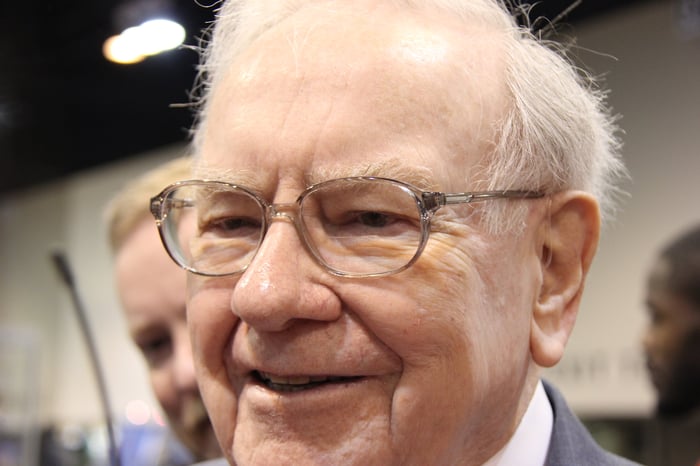Few investors have consistently run circles around Wall Street quite like Berkshire Hathaway (BRK.A 0.43%) (BRK.B 0.47%) CEO Warren Buffett. On an aggregate basis, Buffett has overseen a 3,787,464% increase in his company's Class A shares (BRK.A) since taking the reins nearly six decades ago, which is 153 times greater than the 24,708% return of the benchmark S&P 500, including dividends paid over the same time frame.
The Oracle of Omaha's vast outperformance of Wall Street is due to a laundry list of factors, such as his long-term mindset and desire to own brand-name businesses with trusted management teams. But an undeniable reason Berkshire Hathaway has been such a long-term success, which doesn't get nearly enough attention, is Buffett's affinity for dividend stocks.

You'd be smiling, too, if you were collecting over $6.1 billion annually in dividend income. Berkshire Hathaway CEO Warren Buffett. Image source: The Motley Fool.
Companies that pay a regular dividend are typically profitable on a recurring basis, have transparent long-term outlooks, and are time-tested. Plus, they have a lengthy history of significantly outperforming their non-paying peers over the long run.
If Berkshire Hathaway's current portfolio were to remain unchanged throughout 2023, Buffett's company would be on track to collect about $6.14 billion in annual dividend income. However, a substantial portion of this dividend income (47%) is slated to come from just three holdings -- and Apple isn't one of them!
Chevron: $1,010,816,777 in annual dividend income
Practically a sixth of Berkshire Hathaway's dividend income in 2023 is expected to come from energy stock Chevron (CVX -1.02%). Following a quarterly payout hike earlier this year, Chevron has increased its base annual dividend for 36 consecutive years.
In terms of market value, Chevron is Berkshire Hathaway's third-largest holding ($28.6 billion). Warren Buffett and his investing lieutenants, Todd Combs and Ted Weschler, wouldn't be holding more than $28 billion worth of Chevron stock if they didn't strongly believe that energy commodity prices (specifically oil) wouldn't remain elevated.
Although the Federal Reserve meeting minutes from March points to a mild recession later this year, which wouldn't be good news for crude oil demand and pricing, a couple of macroeconomic factors do validate the idea that crude oil prices could remain above their historic average. Three years of capital underinvestment caused by the COVID-19 pandemic, coupled with Russia's invasion of Ukraine, makes it highly unlikely that oil and natural gas supply can be meaningfully increased anytime soon. When global supply for major energy commodities is constrained, it usually bodes well for spot prices.
Another likely reason Buffett and his team are big fans of Chevron is the company's integrated operating model. Although it generates its juiciest margins from its drilling segment, Chevron also has lucrative midstream (transmission pipelines) and downstream assets (refineries and chemical plants). Midstream assets often produce predictable operating cash flow, while downstream assets provide a hedge against a decline in the spot price of oil.
The icing on the cake for Chevron is that it was able to substantially reduce its net debt last year. This gave its board the green light to approve an up to $75 billion share repurchase program.
Occidental Petroleum: $952,429,702, which includes preferred stock dividends
No, your eyes aren't deceiving you. The company responsible for the second-largest annual dividend payout in Berkshire Hathaway's portfolio is... another oil stock, Occidental Petroleum (OXY -2.56%). The roughly 211.7 million shares of Occidental owned by Berkshire will net $152.4 million in annual dividend income, while the $10 billion preferred stock position Berkshire holds that yields 8% will supply the remaining $800 million.
The catalysts that power Occidental and Chevron are similar, but not the same. The sizable bet the Oracle of Omaha, Combs, and Weschler have made on Occidental is a clear indication that they expect oil and natural gas prices to remain high for years to come.
However, one of the biggest differences between Chevron and Occidental Petroleum is how these companies generate their revenue. Although they're both integrated operators, Chevron gets quite a bit of its annual sales from its midstream and downstream operations. Comparatively, Occidental brings in the lion's share of its revenue from its drilling operations. If crude oil prices were to remain elevated, Occidental would be expected to reap the reward in the form of higher income and cash flow.
Occidental Petroleum is also a bit of a turnaround play. Whereas Chevron has what's arguably the best balance sheet among global energy majors, Occidental has been mired in debt following its 2019 acquisition of Anadarko. While elevated energy commodity prices helped the company reduce its net debt from $35.5 billion at the end of March 2021 to $19.7 billion by the end of 2022, Occidental still needs a favorable macroeconomic climate to improve its financial flexibility.
Suffice it to say, Occidental Petroleum's balance sheet isn't what Warren Buffett typically looks for when making a sizable investment. Then again, it's hard not to be impressed when you're receiving over $952 million in annual dividend income.

Image source: Getty Images.
Bank of America: $908,909,765
The third supercharged dividend stock that collectively accounts for 47% of the more than $6.1 billion Buffett's company will generate in annual dividend income is Bank of America (BAC -0.16%). BofA is Berkshire Hathaway's second-largest holding by market value ($31 billion).
Bank stocks are, arguably, the Oracle of Omaha's favorite industry to put money to work. The reason for this is simple: they're cyclical moneymakers. Though Buffett is well aware that recessions are an inevitable part of the economic cycle, he packs his investment portfolio with cyclical businesses, such as banks, that'll benefit from disproportionately long periods of economic expansion. Bank of America can benefit immensely from loan and deposit growth as the U.S. economy expands.
Chances are that Warren Buffett and his investment team also appreciate Bank of America's industry-leading interest sensitivity. When the Federal Reserve raises interest rates, banks with outstanding variable-rate loans benefit. No money-center bank is more interest sensitive than BofA. During the first quarter, BofA's reported net interest yield surged 51 basis points to 2.2% from the prior-year period, which translated into $14.6 billion in net interest income, a $2.9 billion year-over-year increase.
Perhaps the most surprising thing about Bank of America is the success it's having with its technology investments. You probably wouldn't think of BofA as being on the cutting edge of banking innovation, but it managed to complete 51% of all digital sales online or via mobile during the first quarter. Digital banking is substantially cheaper for banks than in-person or phone-based interactions, which is ultimately a boon for their operating efficiency.
Although the Fed's projection of a mild recession later this year could cloud the capital-return potential of big bank stocks in the short run, Bank of America has a history of delivering for its shareholders via dividends and buybacks over the long-term.





